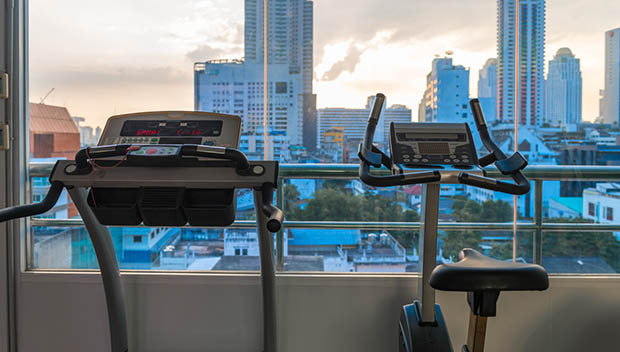
Whether you're traveling for work or for fun, your regular tri training routine will be impacted. Visiting new places can be exciting, and with a little extra planning, you can keep training even when you're away from home. Here are a few tips for scouting locations and dealing with training challenges while away from home to maintain your fitness—and even make improvements.
Understanding What's Available
If training is an important part of your life and you want to minimize the impact of travel on your training, make sure to research what fitness facilities are available when selecting your accommodations. If you are traveling for work, chances are you will be in a hotel; most hotels have a fitness center with some kind of bike and some kind of treadmill. If you are traveling for pleasure and are staying at an Air BnB or other similar accommodations, you might not have all of the same features as a hotel but will have other advantages, like being in a running-friendly neighborhood.
Not All Fitness Centers Are Created Equally
It's important to note that not all hotels—even if they are part of a national chain—provide the same fitness center offerings. Some do not have a fitness center at all while others provide the full gym experience. Most hotels publish some information about their fitness center offerings, and typically will provide a photo so you can see what equipment may be available. But beware: sometimes the photo is just a stock photo and might not represent what's actually available at a specific location. So before you book, call the hotel and ask.
Fitness Centers: Winners and Losers
After checking into a hotel and dropping your gear in your room, it's a good idea to go to check out the fitness center. It's important to find out where it is, what the operating hours are and what equipment is available. This will also help you plan out what you can do to train and when.
Winners: hotels with Peloton bikes. One of the best new trends is for hotels to provide spin bikes or Peloton bikes—not just LifeCycle recumbent options—in their fitness centers. These will help you keep your cycling training going while on your trip. And, Peloton even offers triathlete-specific training sessions.
Losers: limited hours of operation. One of the bigger frustrations are hotels that limit fitness center hours. This may mean an adjustment to your training times or durations. So know before you go.
Repetitive Travel
If you will be traveling for work on a regular basis, explore different hotel chains, even in the same locale, to find the one that can best accommodate your training needs. Once you find your favorite—with the facilities and hours that work for your schedule—you'll be able to plan your training and your working day with more precision. What you won't be able to control is who you'll have to share treadmills and spin bikes with. Remember: Be willing to share equipment, stay flexible and plan an alternative session if the equipment you want to use is already in use.
Swimming While Traveling
While many hotels have pools, they are often not designed for swim training. A creative swimming solution is to swim perimeters of a smaller pool. We've seen and have even been the swimmers ourselves who creatively circle a smaller hotel pool in the mornings when others aren't yet using it. This can be a great way to get a swim in even if it is hard to sort out distance and times.
You may be able to find a local USMS team that allows drop-ins. Check out the U.S. Masters Swimming web site, which provides a directory of USMS member clubs , and contact someone at the club to ask. You may also be able to find a local gym or YMCA that has daily rates for swimming.
Pro Tip: Most USMS swim clubs require liability insurance. Ask if your USAT membership will suffice for proving coverage.
Alternate Swimming Options
You may be able to find a safe place to do some open water swimming . If you do try an open water swim, make sure to research if the body of water is safe and if swimming is allowed. Facebook groups are a great resource for finding safe, recommended spots for open water swims.
Cycling While Traveling
Unless you are traveling with your bike, you are likely going to be doing a lot of your training inside. If you are bringing your bike, consider also bringing your bike trainer in case the local roads are not accommodating for recreational cycling.
Hotel fitness centers are often good options for finding indoor cycling options, but not all gyms are created equal. Aim to find accommodations with the best fitness center bike options to meet your needs, saving you the trouble of having to travel with your bike to keep up with your training. If the hotel website does not offer details, remember that you can always call and ask.
Cycling Around Town
If you don't have your bike with you and you're going to be in a single location for an extended period of time, investigate bike rentals. Bring your helmet, your shoes and your pedals with you, and know your saddle height.
Some larger cities have bike-share programs where you can rent a bike by the hour. Although a bike-share commuter may not be as svelte as your own race bike, it will allow you to get in some time in the saddle, and to explore the city from a different perspective. Not every training session has to be hard.
Running While Traveling
Running is the most efficient way to get a training session in while traveling . All you need to bring is running shoes. Running around town can be a fantastic way to sightsee while also getting in a workout. But make sure you are running in a safe location. Some hotels offer run maps, and you can always ask the concierge or the front desk for tips about running routes and locations. Online resources like Strava, MapMyRun and Garmin Connect display common routes posted by other runners.
Back at the Fitness Center
Unfortunately, it isn't always possible to run outside when traveling, and you may find yourself back in the fitness center on a treadmill or elliptical. This may happen if there isn't a safe place for you to run or if the weather is uncooperative. If you are not used to running indoors, make sure to plan a few breaks in your longer runs. The lack of variation in ground on the treadmill can cause soreness that you don't typically experience, so be aware and don't be afraid to take periodic stretching breaks.
Taking a Day Off
While your normal routine may have you training on specific days and doing specific workouts, sometimes travel just won't allow this. All-day flights or early morning flights followed by a full and busy schedule may mean regular training isn't going to happen. Keep your training as close to normal as you can, but don't beat yourself up if you have to swap workouts or even miss a training session. Traveling takes a physiological toll, so if you find yourself taking a day off, just roll with it. Don't try to make it up; just get through travel and related obligations and pick up with training the next day.
Flexibility Is Key
Most of the time, traveling can be fun and exciting, even if it's for work—it's a change from your routine! Be flexible with your training schedule, and if you have a coach, ask them for help in accommodating training while traveling. Don't get too locked into a plan or be too rigid with the type of workout you do while traveling, as this will only lead to frustration. And don't forget to stretch ! Travel often means extra sitting on top of what you may normally do, and you might be in uncomfortable and cramped locations. Take some time to stretch out your body to help you recover from travel.
READ THIS NEXT: Best Practices When Traveling With Triathlon Gear








Discuss This Article